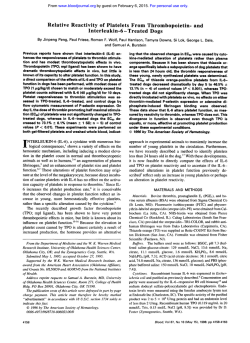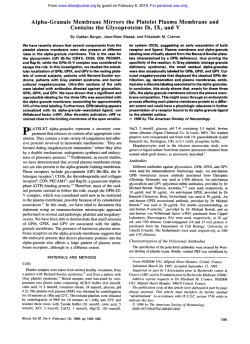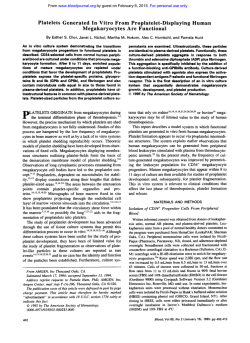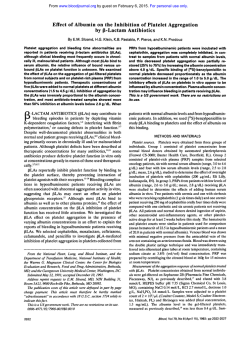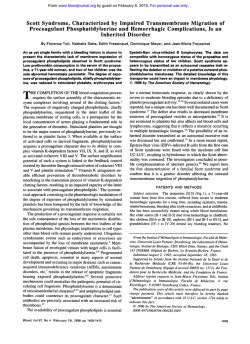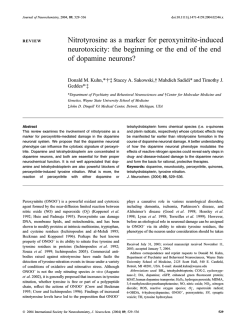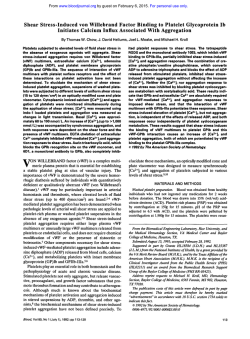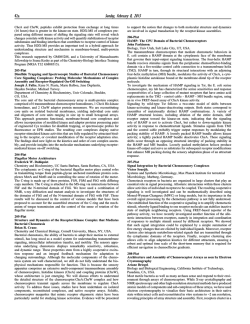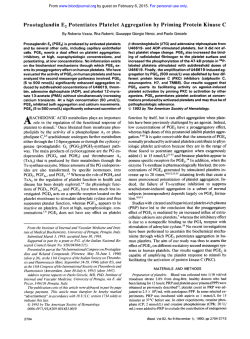
Characterization of Grb2-Binding Proteins in Human
From www.bloodjournal.org by guest on February 6, 2015. For personal use only. Characterization of Grb2-Binding Proteins in Human Platelets Activated by FcyRIIA Cross-Linking By Anne Robinson, Jonathan Gibbins, Belen Rodriguez-Liiiares, Pete M. Finan, Lynn Wilson, Stuart Kellie, Paul Findell, and Steve P. Watson Glutathione-S-transferase(GST)-GrbZfusion proteinshave been used to identify the potential role of GrbZ-binding proteins in platelet activation by the platelet low-affinity IgG receptor, FcyRIIA. Two tyrosine phosphoproteins of 38 and 63 kD bind to the SHZ domain of Grb2 following FcyRllA stimulation of platelets. Both are located in the particulate fraction following platelet activation and are also able to bind to a GST-construct containing the SH2 and SH3 domains of phospholipase C y l . p38 also forms a complex with the tyrosine kinase csk in stimulated cells and is a substrate for the kinase. The SH3 domains of Grb2 form a stable complex with SOSl and two proteins of 75 kD and 120 kD, which undergo tyrosine phosphorylation in FcyRIIA-stimulatedcells. The 75-kD protein is recognized by antibodies to SLP-76, which has recently been isolated from T cells and sequenced. Tyrosine phosphorylation of p38 and p63 is also observed in platelets stimulated by the tyrosine kinase-linkedreceptor agonist collagen and by the G protein-coupled receptor agonist thrombin, although phosphorylation of SLP-76 is only observed in collagenstimulated platelets. p38 and p63 may provide a docking site for Grb2, thereby linking GrbZ SH3-binding proteins SOS1, SLP-76, and p120 to downstream signalling events. 0 1996 by The American Society of Hematology. A sisting of an SH2 domain flanked by two SH3 domains.” The SH3 domains of Grb2 have been shown to interact with a number of proteins including the carboxy-terminal proline rich domain of SOS, a guanine nucleotide exchange factor for ras,” a novel SH2 domain-containing protein SLP-76, which is expressed in hematopoietic cell^,'^,'^ the guanosine triphosphate hydrolase (GTPase) dynamin’‘ and the 120kD protein product of the c-cbl proto-oncogene.” The SH2 domain of Grb2 binds directly to specific phosphotyrosine sequences in receptors such as the epidermal growth factor receptor (EGF-R)I3,l8,’’and the protein tyrosine phosphatase R-PTPa.” It also binds to nonreceptor tyrosine phosphoproteins including the tyrosine phosphatase syp (PTPLD)’’ and the adaptor proteins shc’’ and insulin receptor substrate-1 (IRS-l).23Binding of Grb2 to membrane-localized proteins via its SH2 domain provides a mechanism for the translocation of Grb2 SH3-binding proteins to the membrane. For example, ras activity is regulated by translocation of a Grb2/ SOS complex to the membrane where ras is located.’’ It is becoming increasingly clear that Grb2 is regulated by multiple proteins through its SH2 domain and that it is capable of translocating a number of proteins through its SH3 domains. For example, a human T-cell 36- to 38-kD protein (p36-38), which becomes tyrosine-phosphorylated and membrane-localized following TCR-mediated stimulation, is able to form a stable complex with the SH2 domain of Grb2.24-’hAn equivalent protein has recently been cloned in rat and has been named Lnk.” p36-38 and Lnk have also been shown to bind to PLCyl and phosphatidylinositol 3kina~e.’~.’~ It has been proposed that p36-38Lnk may act as a bridging protein, coupling the TCR to both the Grb2/ras signalling pathway and activation of PLCy 1 .25 In human platelets, we have noted that following FcyRIIA-mediated stimulation, major bands of 38-, 4 5 , and 72-kD are tyrosine-phosphorylated independent of protein kinase C (PKC) activation and Ca’+ elevation.’ The 72- and 45-kD bands have been shown to contain syk and FcyRIIA, respectively,’ but the 38-kD band is as yet unidentified. In view of the homology between syk and ZAP 70 and their similar associations with the ITAMs of the FcyRIIA and the TCR, respectively, we have investigated whether platelet p38 is analogous to the Grb2-binding protein p36-38Lnk in T cells and have also characterized other Grb2-associating proteins. LOW-AFFINITY Fc receptor, FcyRIIA (CD32) mediates the interaction of platelets with immune complexes.’ Cross-linking of Fc yRIIA using specific antibodies mimics the effect of the immune complex and leads to tyrosine phosphorylation of the recepto? and activation of phospholipase Cy2 (PLCy2): The receptor contains a sequence motif that closely resembles the immunoreceptor tyrosine-based activation motif or ITAM (also known as ARAM and TAM) found in the cytoplasmic domain of chains of the T-cell receptor (TCR), B-cell receptor, the high-affinity IgE receptor (FcdU), FcyI, and FcyIII receptor~.’*~ In these receptor complexes, two Y X X M sequences are separated by 6 to 8 intervening residues resulting in the characteristic ITAM motif. In the FcyRIIA, there are 12 residues separating the YXXL sequences, forming an extended ITAM-like motif. The ITAM of FcyRIIA associates with the tandem SH2 domains of ~ y k . ’Syk . ~ is a homolog of the T-cell tyrosine kinase ZAP-70, which interacts with the tyrosine-phosphorylated ITAMs in the 4 chains of the TCR complex.8 Src homology 2 and 3 (SH2 and SH3) domains are recognized as protein modules that play an important role in signal transduction mediated by receptor tyrosine kinases and tyrosine kinase-linked receptors (reviewed in Pawson’). SH2 domains bind to short phosphotyrosine-containing sequences in specific phosphoproteins,” and SH3 domains bind to sequences of approximately 10 amino acids that are rich in proline residues.’’ Mammalian Grb2 (Cuenorhabditis eleguns Sem-5 and Drosophila Drk) is an adaptor protein conFrom the University Department of Pharmacology, Oxford; the Yamanouchi Research Institute, Littlemore Hospital, Oxford, U K ; and Syntex Research, Palo Alto, CA. Submitted September 14, 1995; accepted March I , 1996. Supported by the Wellcome Trust (London, UK). S.P.W. is a Royal Society Research Fellow. Address reprint requests to Steve Watson, PhD, University Department of Pharmacology, Mansfield Road, Oxford OX1 3QT, UK. The publication costs of this article were defrayed in part by page charge payment. This article must therefore be hereby marked “advertisement” in accordance with 18 U.S.C. section 1734 solely to indicate this fact. 0 1996 by The American Society of Hematology. 0006-4971/96/8802-0023$3.00/0 522 Blood, VOI 88, N O 2 (July 15), 1996: pp 522-530 From www.bloodjournal.org by guest on February 6, 2015. For personal use only. 523 GRE-BINDINGPROTEINS IN HUMAN PLATELETS aPY 12389 67 - Fig 1. Rapid and transient tyrosine phosphorylation of a 38-kD molecule. Platelets were stimulated by addition of anti-FcyRIIA MoAb IV.3 (1 pglmL) for 1 minute followed by cross-linker IF(ab’I230 pglmLl for the indicated time or left untreated. Whole cell lysateswere resolved on 10% SDS-PAGE and immunoblotted using antiphosphotyrosine MoAb 4610. Results are representative of 10 experiments. 4 50 37.5 34- MATERIALS AND METHODS Antibodies and reagents. Monoclonal antibody (MoAb) 4G10 specific for phosphotyrosine, PLCy 1 MoAb, polyclonal anti-SOS antibody, and mitogen-activated protein (MAP) kinase MoAb (recognizing p42 MAP kinase) were purchased from Upstate Biotechnology Inc (TCS Biologicals Ltd, Bucks, UK). Polyclonal anti-Grb2 antibody and p62 MoAb were purchased from Affiniti Research Products Ltd (Nottingham, UK). FcyRll specific MoAb was purchased from Madarex Inc (Annandale, NJ). CD3 MoAb, OKT3 was a kind gift from Denis Alexander (Babraham, Cambridge, UK). Polyclonal csk antibody was purchased from Santa CNZ Biotechnology (Autogen Bioclear UK Ltd, Devizes, Wilts, UK). Polyclonal anti-SLP-76 antibody was raised by Paul Findell. Anti-src MoAb was a gift from Joan Brugge (Ariad Pharmaceuticals Inc, Cambridge, MA). Sheep F(ab’)2 raised against mouse IgG (M-1522), Nonidet P-40 (NP-40). thrombin, and Triton-X-I00 were purchased from Sigma (Poole, Dorset, UK). Collagen (native collagen fibrils from equine tendons) was from Nycomed (Munich, Germany). [Y-~*P] adenosine triphosphate (ATP specific activity [s.a.], 3,000 Ci/mmol) was purchased from N.E.N.-DU Pont (Stevenage, Herts, UK). Peptide. The EGF receptor peptide with the sequence PVPE-Y (phosphate)INQS, corresponding to the autophosphorylation site of the receptor, has been described previously” and was kindly provided by Julian Downward (Imperial Cancer Research Fund, Lincoln’s Inn Fields, London, UK). The equivalent nonphosphorylated peptide was purchased from Zinsser Analytic (Maidenhead, Berkshire, UK). Fusion proteins. Fusion proteins encoding glutathione-s-transferase (GST)-Grb2 myc and double SH3 mutant GST-Grb2 myc P47UG203R have been described previou~ly’~ and were kindly provided by Sean Egan (Whitehead Institute for Biomedical Research, Massachusetts Institute of Technology, Cambridge, MA). PIatelet preparation. Human platelets were isolated from drugfree volunteers on the day of the experiment according to the guidelines in the Helsinki Doctrine. They were resuspended at a concentration of 0.8 to 1.6 x 109/mL.Platelets were suspended in a modified Tyrodes-HEPES buffer containing indomethacin (10 pmol/L) and EGTA (1 mmoVL). and incubated for 15 minutes before the experiment.’ All experiments were performed at 37°C with continuous stirring at 1,200 rpm. T-cell culture. The human leukemic Jurkat T-cell line was provided by the Department of Pathology, Oxford University and was cultured in RPMI 1640 supplemented with 10% fetal calf serum. Cell activation. Platelets were stimulated via FcyRIIA using MoAb IV.3 ( I pglmL) and the cross-linker [F(ab’)2 30 pg/mL], which was added after 1 minute (the latter time was taken at the beginning of the experiment). Platelets were stimulated by collagen 70kDa 4 FcyFUIA 4- 38kDa 10” 20” W W 2’ 5’ 1(Y FcyIUIA cross-linking time at 100 pg/mL and by thrombin at 1 U/mL. Reactions were stopped for precipitation after 2 minutes of stimulation by addition of an equal volume of cold lysis buffer (NaCI. 300 mmolk: Tris, 20 mmol/L; phenylmethylsulfonyl fluoride [PMSF], 1 mmolk, EDTA, 10 mmolk, Na3VO4, 2 mmol/L; pH 7.3 containing Triton X-100, 2%); in some experiments NP-40 (1%) was used instead of Tritox X-100. Following lysis, the insoluble fraction was removed by centrifugation at 13,000 rpm for 10 minutes at 4°C. For Western blotting of whole cell lysates, reactions were stopped after the indicated time by addition of nonreducing Laemmli sodium dodecyl sulfatepolyacrylamide gel electrophoresis (SDS-PAGE) sample buffer. T cells were washed once in phosphate-buffered saline before stimulation via the TCR by cross-linking CD3 using OKT3 (1 pg/ mL). Cross-linker [F(ab’), 8 pg/mL] was added after 1 minute, and reactions stopped after 2 minutes by pelleting the cells in a microfuge at 13,000 rpm for 5 seconds and adding cold lysis buffer to the pellet. Following lysis, the Triton insoluble fraction was removed by centrifugation at 13,000 rpm for 10 minutes at 4°C. For Westem blotting of whole cell lysates, reactions were stopped after the indicated time by addition of nonreducing Laemmli SDS-PAGE sample buffer. Precipitation and depletion. Lysates were precleared for 1 hour at 4°C using glutathione beads and then incubated with 25 pg of GST fusion protein immobilized on glutathione-coated beads for 2 hours at 4°C. Precipitates were washed twice in 500 pL of lysis buffer and three times in 500 pL Tris-buffered saline containing 0.1% Tween (TBS-T). If depletion of 38 kD was required, the 2hour precipitation step was replaced by three 45-minute incubations with 25 pg of GST-Grb2 (mut) fusion protein immobilized on glutathione beads. The resulting depleted cell lysates were used for precipitation. Immunoprecipitation. Lysates were precleared for I hour at 4°C using protein A-Sepharose and then incubated with 5 pg of p5WSk MoAb, immobilized on protein A-sepharose, for 2 hours at 4°C. Precipitates were washed twice in 500 pL of lysis buffer and three times in 500 pL TBS-T. In vitro kinase assav. p5W“ complexes were precipitated from cell lysates as described above. Assays were performed in 20 pL of kinase buffer (5 mmol/L MgClz. 5 mmol/L MnCI2, 100 mmolR. NaCI, 20 mmol/L HEPES, and 5 pCi [y-”PIATP). Reactions were performed for 10 minutes at room temperature and stopped by addition of 0.5 mL of ice cold 100 mmol/L EDTA (pH 7.4). SDS-PAGE. Samples were boiled in nonreducing SDS-PAGE sample buffer for 15 minutes. Samples were then resolved by SDSPAGE (10%) and transferred to polyvinylidene fluoride (PVDF). [y”P]-labeled phosphoproteins were visualized by autoradiography. Altematively, the membranes were immunoblotted using the indi- From www.bloodjournal.org by guest on February 6, 2015. For personal use only. ROBINSON ET AL 524 A 123- D aGrb2 8938kDa -b 6750- 37.534- + - + + - u t 50 - - GST GST-Grb; platelet whole cell lysate B 63kDa aPY aPY + + - + + "lu , [M W38 kDa + GST GSTGrb2 (wt) 123- EGF-Rpeptide - E 34- , + , , - + , FqRIIA C - FcyRnA but) t 7 5 kDa t 6 3 kDa 50 37.5 -~ I - I GST GST-Grb2 C120 kDa 123 89 -. 67 - FcyRlIA EGF-R peptide [ILM1 - + + + - S SO U- FcyRllA EGF-R peptide GST GST-Grb2 W ) platelets JurkatT-cells " aPY 89 - 67- a" 63kDa 50- 63kDa + + + FcyRIlA + 5 GST GST-Grb2 *38kDa 37.534- + U- 50 EGF-R peptide W ) + - + + - + " -U GST GSTGSTGST Grb2 (mut) Grb2 (mut) 7SkDa aPY + + " - - + GST GST-Grb2 + FcyRlIA 50 EGF-R peptide [PM1 W ) cated antibody followedby secondary antibody conjugated to horseradish peroxidase and Enhanced Chemiluminescence (ECL) detection. Subcellular fracrionarion. Subcellular fractionationwasperformed after activation of platelets. Cells were resuspended inan equalvolume of hypotonicbuffer (10 mmol/LTris. 1 mmol/L EDTA, 1 mmolL PMSF, I mmolL Na3V04) and sonicated on ice for 1 minute. The lysate was centrifuged at 1,OOOg for 10 minutes to remove whole cells and large debris. The supernatant was centrifuged at lO0,OOOg for 1 hour and the supernatant (cytosolic fraction) From www.bloodjournal.org by guest on February 6, 2015. For personal use only. GRB-BINDING PROTEINS IN HUMAN PLATELETS 525 Fig 2. Grb2 binds to a 38-kD tyrosine phosphoproteinvia its SH2 domain. (A) Unstimulated platelets were lysed in nonreducing SDS-PAGE sample buffer, resolved on 10% SDS-PAGE, and immunoblotted using Gib2 antibody. (61Platelets were left untreated or stimuleted by addition of anti-FcyRWA MoAb IV.3 (1pglmL) for 1 minute followed by cross-linker [F(ab'Iz 30 pglmL1 for 2 minutes. Cdls were then lysed in buffer containing 1% Triton X-100. A 25-pglatsay of GST alone or GST-GrbZltwt)fusion protein was immobilized on glutathione-coated agarose beads and used for protein precipitation from pletdet lysates. Bound proteins were resolved on 10% SDS-PAGE and immunoblotted using antiphosphotyrosine MoAb 4610. (C) Platelets were left untreated or stimulated as described above. Jurkat T cells were left untreated or stimulated by addition of anti-CD3 MoAb OKT3 (1 pg/mL) for 1 minute followed by addition of cross-linker [F(ab'), 8 pglmL1 for 2 minutes. Stimulation is indicated by the (+Isign below the correaponding lane. Cells were lysed in buffer containing 1% Triton X-100. A 25-pglatsay of GST alone or GST-GrbZ(mut)fusion protein was used for protein precipitation from platelet and T-cell lysates. Bound proteins were resolved on 10% SDS-PAGE and immunoblotted with antiphosphotyrosineMoAb 4610. (D) Platelets were left untreated or stimulated as described above and lysed in buffer containing 1% Triton X-100. A 25-pglasray of GST alone and GSTGrb2(mut)fusion protein was used to precipitate from platelet lysates. EGF-R peptide was added to the cell lysates at the indicatedconcentrations along with the fusion protein. Bound proteins were resolved on 10% SDS-PAGE and immunoblotted with antiphosphotyrosineMoAb 4610. The three parts of the figure were taken from separate ECL exposures because of differing intensities in phosphorylation of each protein. (E) Platelets were left untreated or stimulated as described above and lysed in buffer containing 1% Triton X-100. A 25-pglassay of GST alone and GSTGrb2(wt) fusion protein was used to precipitate from platelet lysates. EGF-R peptide was added to the cell lysates at the indicated concentrations along with the fusion protein. Bound proteins were resolved on 10% SDS-PAGE and immunoblotted with antiphosphotyrosineMoAb 4610. Representativeresults from two separate experiments are shown. i used directly for precipitation, The pellet (particulate fraction) was dissolved with 1% Triton X-100 and used for precipitation. RESULTS p38 is tyrosine-phosphorylated in a rapid, but transient, manner in FcyRIIA-stimulated platelets. Fc yRIIA crosslinking induces tyrosine phosphorylation of multiple proteins (Fig 1). Of particular interest are rapidly phosphorylated bands at 72, 45, and 38 kD. We have shown that the 45and 72-kD bands contain FcyRIIA and syk, respectively, and that tyrosine phosphorylation of these three bands is independent of PKC activity and Ca2+release.* This is consistent with these proteins playing a role in linking the Fc yRIIA receptor to a signal transduction pathway upstream of PLCy2. Tyrosine phosphorylation of the 72-kD protein occurs within 10 seconds of stimulation, peaks at 60 seconds, and is sustained for the 10-minute time course of the experiment. Phosphorylation of the FcyRIIA and p38 is rapid, but transient, peaking at 1 minute and returning to near basal levels after 10 minutes. The time course of phosphorylation of p38 is similar to that of T cell p36-38Lnk following CD3mediated s t i m u l a t i ~ n implying ,~~ that both proteins play a role in early activation events. Tyrosine-phosphoryhtedGrb2-binding proteins in FcyRIL4stimulated platelets. The 2.54) adaptor protein Grb2 was detected in platelet cell lysates by Western blotting (Fig 2A). Precipitation from platelet cell lysates using a wild-type (wt) GST-Grb2 fusion protein followed by antiphosphotyrosine Western blotting showed the presence of several coprecipitating tyrosine phosphoproteins. These included a 38-kD doublet, 63-, 7 5 , and 120-kD proteins and a broad band above 123 kD (Fig 2B). The 63-kD tyrosine phosphoprotein was coprecipitated with GST-Grb2(wt) in both basal and activated platelets. There was considerable donor variability in relative intensity of phosphorylation of the above proteins in stimulated cells. In particular, marked increases in tyrosine phosphorylation of the 63-kD band were observed on stimulation in some, but not all, experiments. Grb2 SH2-binding proteins. A mutated form of GSTGrb2 [GST-Grb2(mut)], in which the SH3 domains have been made nonfunctional by single point m ~ t a t i o n ,precipi'~ tates 38- and 63-kD tyrosine phosphoproteins in Fc yRIIAstimulated platelets (Fig 2C) providing evidence that they bind to the SH2 domain of Grb2. It is likely that both SH2binding proteins interact independently with Grb2, as there is no consistent ratio of Grb2 association between p38 and p63 from experiment to experiment. Indeed, in a number of experiments, each of the two bands has been seen to associate with GST-Grb2(mut) despite barely detectable levels of the other. This variability may represent differences between blood donors in the kinetics or extent of phosphorylation of p38 and p63 or in expression of these two proteins. p63 does not bind to GST-Grb2(mut) under basal conditions in contrast to results seen with wild-type GST-Grb2. This suggests that binding of p63 to Grb2 under basal conditions requires functional SH3 domains or that there is more than one 63-kD Grb2-binding protein. A Grb2 SH2-binding phosphopeptide corresponding to the autophosphorylation site of the EGF-R inhibited completely p38 binding to GST-Grb2(mut) (Fig 2D) and GST-Grb2(wt) (Fig 2E); in contrast, the nonphosphorylated EGF-R peptide did not inhibit binding of p38 (not shown). These observations confirm that p38 binds to the SH2 domain of Grb2. The phosphorylated EGF-R peptide inhibited completely the binding of p63 to GST-Grb2(mut) (Fig 2D), but only partially competed out the binding to GST-Grb2(wt) (Fig 2E). The nonphosphorylated EGF-R peptide did not inhibit binding of p63 (not shown). These results are consistent with those described above and strengthen the argument that p63 is an SH2/SH3 binding protein or that there are two proteins of this molecular weight, one of which is SH2-binding and the other, which is SH3-binding. In some experiments, the 63-kD band was resolved as a doublet. We investigated the subcellular localization of p38 and p63 following platelet activation. Particulate and cytosolic fractions were made from platelets stimulated by FcyRIIA cross-linking. GST-Grb2 was added to both fractions, and the bound tyrosine phosphoproteins analyzed by SDS-PAGE followed by Western blotting. Figure 3 shows that both p38 and p63 were found exclusively in the particulate fraction following Fc yRIIA-mediated stimulation of platelets. Antibodies raised against these molecules are required to deter- From www.bloodjournal.org by guest on February 6, 2015. For personal use only. ROBINSON ET AL 526 mine localization of their unphosphorylated forms. To confirm that fractionation had separated cytosolic from particulate proteins, we probed for MAP kinase, which is known to be located in the cytosol. As shown in Fig 3, MAP kinase partioned to the cytosolic fraction. It is possible, therefore, that p38 and p63 may act to recruit Grb2 and its associated proteins to the particulate fraction following cell activation. Characterization of p38. Platelet p38 comigrates with the T-cell GrbZbinding protein p36-38Lnk (Fig 2C). This protein was originally characterized as a 36- to 38-kD molecule that associates with the SH2 domain of Grb2 following TCR-mediated stimulation of Jurkat T ~ e l l s . ~It~is. ~not ’ clear whether platelet p38 and T cell p36-38 are related, although both are found in the particulate fraction following cell activation. T cell p36-38Lnk has been shown to form a trimeric complex with Grb2 and PLCy 1.25.2h We have confirmed the PLCyVGrb2 interaction in Jurkat T cells by Western blotting GST-Grb2(mut) complexes for PLCyl (not shown), but have been unable to show a similar interaction between GSTGrb2(mut) and platelet PLCyl (not shown). It is possible that this result reflects a low level of PLCyl expression in platelets. This is supported by the observation that a 38-kD tyrosine phosphoprotein from FcyRIIA-activated platelets associates (together with 63- and 75-kD tyrosine phosphoproteins) with a GST fusion protein consisting of the SH2 and SH3 domains of PLCyl (not shown). It has been reported that following platelet stimulation via FcyRIIA, it is PLCy2 and not PLCy 1 that becomes tyrosine phosphorylated: To assess whether a GST-Grb2PLCy2 interaction might occur in platelets, we used GST-Grb2(mut) to precipitate lysates from FcyRIIA-stimulated platelets. However, Westem blotting the GST-Grb2(mut) complexes for PLCy2 did not show an interaction (not shown). The tyrosine kinase csk catalyzes phosphorylation of srclike protein tyrosine kinases on a negative regulatory tyrosine residue located near the carboxy terminu~.~’ A recent report has shown that in response to cross-linking of FcyRIIA receptors on human erythroleukemia (HEL) cells and human platelets, csk becomes tightly associated with a tyrosine phosphorylated protein of 36 kD, which is found exclusively in the particulate fraction of the HEL celk2*To clarify the relationship between the platelet Grb2-binding p38 and the p36, which interacts with csk, we performed in vitro kinase assays on csk immunoprecipitates from platelet cell lysates with or without depletion of the p38 GrbZbind- aMAPkinase aPY kinase m aPY 463kDa P+38ma 4- c ing protein. Figure 4 shows that a molecule with a molecular weight of 38 kD becomes phosphorylated in immunoprecipitated csk complexes in agreement with the results of Ford et a12xin HEL cells. This molecule was absent in in vitro kinase assays performed on csk immunoprecipitates from cell lysates depleted of p38 GrbZbinding protein by repeated GST-Grb2(mut) precipitation. This result strongly suggests that the 38-kD protein, which becomes phosphorylated in platelet csk complexes, is the same as the platelet p38 Grb2-binding molecule. We also considered the possibility that p38 is itself a kinase and that phosphorylation in csk complexes may be due to autophosphorylation. However, in vitro kinase assays of GST-Grb2(mut) precipitates do not show kinase activity associating with the fusion protein (data not shown) suggesting that p38 and other associated proteins, eg, p63, do not have intrinsic kinase activity. Characrerizarion ofp63. Platelet p63 comigrates with a T-cell tyrosine phosphoprotein that also binds to the SH2 domain of Grb2(mut) following TCR stimulation of Jurkat T cells (Fig 2C). It is not clear whether these two proteins are related. We have not determined whether the T-cell 63kD GrbZbinding protein described here is ras GAP binding p62, which has been shown to interact with the SH2 domain of Grb2 in T cells.2g Proteins that are candidates for platelet p63 include the ras GAP binding protein p62, the adaptor protein shc, and c-src kinase. Western blotting of platelet whole cell lysates indicates that while ras GAP binding protein p62 is clearly expressed in T cells, it is undetectable in platelets (not shown). The adaptor protein shc interacts with the SH2 domain of Grb2 and is expressed in three forms of 46, 52, and 62 kD.We were unable to detect the 62-kD form of shc in platelets by Western blotting (data not shown) demonstrating that the p63 GrbZbinding protein is not shc. We also considered that the p63 Grb2-binding protein might be the abundant platelet kinase c-src, but were unable to show an association between c-src and GST-Grb2(wt) (not shown). Grb2 SH3-binding proteins. Several recent studies have demonstrated that SOS and Grb2 form a stable complex via the proline rich C-terminal region of SOS and the SH3 domains of Grb2.’*.I9GST-Grb2(wt) fusion protein was used to precipitate lysates of basal and FcyRIIA-activated platelets, and the Grb2 complexes were then Western blotted using mSOSl antibody. Figure SA shows that SOSl is present in platelets and that a low level of SOSl binds to GSTGrb2(wt), but not to GST-Grb2(mut) (not shown), in both c m c m Fig 3. The 38-kD tyrosine phosphoprotein is found only in the particulate fraction. Platelets were stimulated by addition of anti-FcyRIlA MoAb IV.3 (1 pg/mL) for 1 minute followed by cross-linker [F(ab‘)* 30 pg/mL] for 2 minutes. A 25-pglassay of GST-GrbZ(wt) fusion protein was used to precipitate from both cytosolic (e) and membrane (m) fractions prepared as described in Materials and Methods. Associated proteins were resolved on 10% SDS-PAGE and immunoblotted using antiphosphotyrosine MoAb 4610. Unprecipitated cytosolic and particulate fractions were immunoblotted using anti-MAP kinase MoAb. From www.bloodjournal.org by guest on February 6, 2015. For personal use only. 527 GRB-BINDING PROTEINS IN HUMAN PLATELETS iuka 123 - . A aSOSl 89 - 675037.5 ~~ 4-38kDa 34- - + + + FcyRIIA GST-Grb2 depletion 123 89 67 - 50 37.5 34- a csk mAb Fig 4. p38 associates with and is a substrate for csk. Platelets were stimulated by addition of anti-FcyRIIA MoAb IV.3 (1 pglmL) for 1 minute followed by cross-linker IF(ab’)* 30 pglmL1 for 2 minutes. Cells were lysed in buffer containing 1%Triton X-100. Cell lysates were depleted of the 38-kD Grb2-binding protein by sequential precipitation using GST-Grb2lmut) as described in Materials and Methods. Cell lysates were immunoprecipitated using polyclonal anti-csk antibody (5 pglassay). In vitro kinase assays were performed on the csk precipitates as described in Materials and Methods. The upper panel shows an autoradiogram of the in vitro kinase assay and the lower panel an immunoblot of the same membrane using polyclonal anti-csk antibody. The results are representative of t w o experiments. resting and activated cells. The apparently low level of SOSl binding to GST-Grb2 may reflect a constitutive association between endogenous Grb2 and SOSl or the promotion of other Grb2 SH3 interactions by platelet Grb2 SHZbinding proteins.” The 75-kD and 120-kD tyrosine phosphorylated proteins that bind to GST-Grb2(wt) did not bind to GST-Grb2(mut) (Fig 2C). The binding of p75 to GST-Grb2(mut) was partially (<10%) reduced by a relatively high concentration of the phosphorylated EGF-receptor peptide (50 pmol/L) (Fig 2E), but not by the nonphosphorylated peptide (50 pmol/L) (not shown). This may reflect a nonspecific action of the phosphorylated peptide or that the SH2 domain of Grb2 contributes to the interaction of p75 with Grb2. These results strongly suggest that the 75-kD and 120-kD proteins bind to one or both of the SH3 domains of Grb2. A novel T cell Grb2-binding protein of 75 kD has been cloned and is an SH2 domain-containing protein named SLP76 (SH2 domain-containing Leukocyte Protein of 76 kD).I5 Western blotting of GST-Grb2 (wt) precipitates using anti SLP-76 antisera indicates the presence of a 75-kD band that comigrates with the 75-kD tyrosine-phosphorylated Grb2binding protein. SLP-76 binds to GST-Grb2(wt) (Fig 5B). but not GST-Grb2(mut) (not shown) in lysates from both basal and activated platelets, demonstrating that it interacts with one or both of the SH3 domains of Grb2. Grb2-binding proteins in collagen- and thrombin-stimuluted cells. Stimulation of platelets via the tyrosine kinaselinked FcyRIIA and collagen receptors or the G-protein- - wcl + - --u+=k + :FcyRIIA GST GST-Grb2 (wt) B OrSLP-76 123 89 - 4SLP-76 67 50 37.5 34 - + - + :FcyRIIA GST GST- wcl Grb2 Fig 5. SOSl and SLP-76 associate with Grb2 in basal and activated platelets. (AI Platelets were left untreated or stimulated by addition of anti-FcyRllA MoAb IV.3 (1 pglmL) for 1 minute followed by crosslinker 1F(ab’l230 p g l m L l for 2 minutes. Cells were then lysed in buffer containing 1% Triton X-100. A 25-pglassay of GST alone or GSTGrb2(wild type Iwtl)fusion protein was immobilized on glutathione coated agarose beads and used for protein precipitation from p l a t e lets lysates. Bound proteins were resolved on 10% SDS-PAGE and immunoblotted using polyclonal anti-SOS antibody. Results are representative of three experiments. IB) Platelets were left untreated or stimulated by addition of anti-FcyRIIA MoAb IV.3 (1 pglmL) for 1 minute followed by cross-linker [Flab‘)* 30 pglmL1 for 2 minutes. Cells were then lysed in buffer containing 1% Triton X-100. A 25-pgl assay of GST alone or GST-GrbZtwt) fusion protein was immobilized on glutathione-coated agarose beads and used for protein precipitation from platelets lysates. Bound proteins were resolved on 10% SDS-PAGE and immunoblotted using polyclonal anti-SLP-76 antibody. The right side of the figure shows the presence of SLP-76 in whole cell lysate Iwcl). Results are representative of t w o experiments. From www.bloodjournal.org by guest on February 6, 2015. For personal use only. ROBINSON ET AL 528 A I! aPY 1 2 3- 4 12OkDa 89 - -7SkDa 463kDa 37.5 34 - 438kDa 67 SO - -+ - aI’Y B i + Collagen GST GSTGrb2 (wt) 123 89 67 - 4 120kDc1 D so - 37.5 31 - 463kDa 438kDn , + , , - +,Thrombin GST GSTGrb2 (M’t) Fig 6. GST-Grb2 (wild-type [wtll-binding tyrosine phosphoproteinsin FcyRIIA, collagen- and thrombin-stimulated platelets. Plateletswere left untreated or stimulated by addition of collagen (100 pg/mL) for 2 minutes or thrombin (10 U/mLl for 2 minutes. Cells were then lysed in buffer containing 1% Triton X-100. A 25-pglassay of GST alone or GST-Grb2(wtl fusion protein was immobilized on glutathione-coatedagarose beads and used for protein precipitation from platelets lysates. Bound proteins were resolved on 10% SDS-PAGE and immunoblotted using antiphosphotyrosine MoAb 4610. The positions of 38-, 63-, 75-, and 120-kD tyrosine-phosphorylatedproteins are shown (p75 was not detected in thrombin-stimulated platelets and is not hidden by the 63-kD band). Results are representative of five experiments. linked thrombin receptor induces tyrosine phosphorylation of distinct, but overlapping, sets of proteins. We, therefore, investigated whether stimulation via collagen and thrombin receptors induced phosphorylation of p75 and pl20 and association between Grb2, p63, and p38. Figure 6 shows that both stimuli induced comparable GST-Grb2(wt) association with p63 and p38 and phosphorylation of p120. However, while p75 was tyrosine phosphorylated following collagenmediated stimulation, it remained unphosphorylated following thrombin-induced activation. DISCUSSION The present study has demonstrated that two tyrosine phosphorylated proteins of 38 kD and 63 kD associate with the SH2 domain of Grb2 following FcyRIIA-mediated stimulation of platelets. Tyrosine-phosphorylated p38 and p63 were both found exclusively in the particulate fraction of platelets. Their association with Grb2 may therefore function to relocate cytosolic Grb2 and its associated SH3-binding proteins to the particulate fraction following cell activation. p63 and p38 might dock Grb2 to different sites within the cell, bringing SH3-binding proteins into contact with a different range of substrates. In this way, platelet p63 and p38 may link the FcyIIA receptor to at least two different signal transduction pathways via Grb2. A recent report has shown that following stimulation of mast cells via the ITAM-containing FceRI, a 33-kD tyrosine phosphoprotein binds to the SH2 domain of Grb2.3’ It is possible that mast cell p33, T cell p36-38Lnk. and platelet p38 form a group of small molecular weight proteins that link ITAM-containing receptors to Grb2. Seih et a125have shown that p36-38Lnk in T cells mediates an interaction between Grb2 and PLCyl and propose that p36-38 links the TCR to both the ras pathway and the generation of second messengers by PLCy 1. We have not detected an association between GST-Grb2 and PLCyl in platelets. This result may indicate that T cell p36-38Lnk and platelet p38 are structurally different or that the level of PLCyl expression in platelets is not sufficient for this association to occur at detectable levels. Although we cannot differentiate between these two possibilities at present, we have noted that a 38-kD tyrosine phosphoprotein in FcyRIIA-stimulated platelets associates with a GST fusion protein containing the SH2 and SH3 domains of PLCyI. In HEL cells and platelets Ford et aI2’ have described a 36-kD molecule that associates with and is phosphorylated by csk following FcyRIIA-mediated stimulation. This association is dependent on the SH2 domain of csk. The 38-kD Grb2-binding molecule that we describe here also associates with and is phosphorylated by csk strongly suggesting that p38 may be the same molecule as that described by Ford et The association between p38 and csk may function to relocate the cytosolic kinase to the particulate fraction bringing it into contact with its substrate, ie, a member of the src family of tyrosine kinases. There is considerable evidence for a role of src-like tyrosine kinases in signaling by immune receptors containing ITAM motifs.’ The src-like kinase is believed to associate with the nonphosphorylated receptor and to mediate phosphorylation of the ITAM. In this model, csk might take part in a negative feedback pathway acting to inhibit or switch off the FcyRIIA-mediated signal. Srclike kinases have been shown to associate with the FcyRIIA in monocytic THP-1 cells (p56/53’”’ and p59h‘L)3Zand in neutrophils We have also described the association between FcyRIIA and an unidentified tyrosine kinase in unstimulated platelets.’ Three Grb2 SH3-binding proteins have been described in this study, two tyrosine-phosphorylated proteins of 75 and 120 kD and SOS1, the exchange factor for ras. Following TCR-induced stimulation of T cells, Grb2 links the TCR to the ras signalling pathway via SOS resulting in activation of ras downstream effector molecules such as MAP kinase.’ The presence of ras in platelets is however controversial. Manning and Brass34have reported that it is absent from From www.bloodjournal.org by guest on February 6, 2015. For personal use only. GRB-BINDINGPROTEINS IN HUMAN PLATELETS platelets, while Bhullar and H a ~ l a mhave ~ ~ observed a low level of expression. Although stimulation of platelets via collagen or thrombin results in activation of MAP kinase, this is blocked by a PKC inhibitor indicating that it is independent of ras or that the ras-MAP kinase pathway requires coactivation of PKC.36 By analogy with SOS, it is likely that p120 and p75 are Grb2 effectors and that their relocalization brings them into contact with their substrates. p75 is recognized by antibodies to T-cell SLP-76, an SH2-containing protein that has no apparent enzymatic activity, but contains a number of SH2and SH3-binding regions. The function of p75 is not known. The pl20 tyrosine phosphoprotein may be related to the proto-oncogene product c-cbl, which has been shown to interact with Grb2 in T ~ e l l s ' ~and , ~ 'which becomes phosphorylated following FcyRIIA-mediated stimulation of HL-60 The tyrosine kinase-linked collagen receptor and the Gprotein-linked thrombin receptor also appear to link to Grb2mediated signaling pathways. As with activation of platelets by FcyRIIA-cross-linking, both thrombin and collagen stimulate phosphorylation of p120 and binding of tyrosine phosphorylated p38 and p63 to the SH2 domain of GST-Grb2. However, while collagen-induced platelet activation results in tyrosine phosphorylation of p75, this protein is not phosphorylated in thrombin-stimulated cells. This may indicate that the role of Grb2 differs between platelets stimulated by G-protein and tyrosine kinase-linked receptors. It is important to emphasize that although the present study has provided evidence for association of proteins with the SH2 and SH3 domains of Grb2 in platelets activated by FcyRIIA cross-linking and other agonists, the functional significance of these interactions is not known. Indeed, the interaction of SOS 1 with the SH3 domain of Grb2 may have little or no physiological relevance in platelets, possibly due to a low level of expression of ras as discussed above. Determination of the importance of these interactions in platelet activation will require the initial identification of p38, p63, and p120 and an understanding of their role and that of p75 in cell signaling. The importance of these interactions may become apparent through studies on platelets isolated from animals that lack the relevant protein or its downstream target. ACKNOWLEDGMENT We would like to thank Sean Egan for his gift of GST-Grb2 myc and GST-Orb2 myc P47L/G203R, Julian Downward for useful advice and his gift of EGF-R peptide, and Denis Alexander for his gift of OKT3 MoAb. REFERENCES 1. Chacko GW, Duchemin A, Coggeshall KM, Osbome JM, Brand JT, Anderson CL: Clustering of the platelet Fcy receptor induces noncovalent association with the tyrosine kinase ~ 7 2 ~J' . Biol Chem 269:32435, 1994 2. Blake RA, Asselin J, Walker T, Watson SP: Fcy receptor I1 stimulated formation of inositol phosphates in human platelets is blocked by tyrosine kinase inhibitors and associated with tyrosine phosphorylation of the receptor. FEBS Lett 342:15, 1994 3. Huang M, Indik 2 , Brass LF, Hoxie JA, Schreiber AD, Brugge 529 JS: Activation of FcyRII induces tyrosine phosphorylation of multiple proteins including FcyRII. J Biol Chem 2675467, 1992 4. Blake RA, Schieven GL, Watson S P Collagen stimulates tyrosine phosphorylation of phospholipase C y2 but not PLC y l in human platelets. FEBS Lett 355:212, 1994 5. Weiss AT, Littman DR: Signal transduction by lymphocyte antigen receptors. Cell 76:263, 1994 6. Ravetch JV: Fc receptors: Rubor redux. Cell 78553, 1994 7. Yanaga F, Poole A, Asselin A, Blake R, Schieven GL, Clark EA, Law C-L, Watson SP: Syk interacts with tyrosine phosphorylated proteins in human platelets activated by collagen and crosslinking of the FCy-IIA receptor. Biochem J 311:471, 1995 8. Gaven LK, Zhu Y,Letourneur F, Hu Q, Bolen JB, Matis LA, Klausner RD, Shaw AS: Interactions of p 5 p and ZAP-70 with Tcell receptor activation motifs: Defining the nature of a signalling motif. Mol Cell Biol 14:3729, 1994 9. Pawson T: Protein modules and signalling networks. Nature 373:573, 1995 IO. Songyang 2, Shoelson SE, Chaudhuri M, Gish G, Pawson P, Haser WG, King F, Robets T, Ratnofsky S, Lechleider RJ, Nee1 BG, Birge RB, Fajardo JE, Chou MM, Hanafusa H, Schamausen B, Cantley JC: SH2 domains recognize specific phosphopeptide sequences. Cell 72:767, 1993 11. Ren R, Mayer BJ, Cicchetti P, Baltimore D: Identification of a ten-amino acid proline-rich SH3 binding site. Science 259: 1157, 1993 12. Downward J: The GRB2ISEM-5 adaptor protein. FEBS Lett 338:113, 1994 13. Egan SE, Giddings BW, Brooks M W ,Buday L, Sizeland AM, Weinberg RA: Association of Sos Ras exchange protein with Grb2 is implicated in tyrosine kinase signal transduction and transformation. Nature 363:45, 1993 14. Reif K, Buday L, Downward J, Cantrell DA: SH3 domains of the adapter molecule Grb2 complex with two proteins in T cells: The guanine nucleotide exchange protein Sos and a 75kDa protein that is a substrate for T cell antigen receptor-activated tyrosine kinases. J Biol Chem 19:14081, 1994 15. Jackman JK, Motto DG, Sun Q. Tanemoto M, Turck CW, Peltz GA, Koretzky GA, Findell PR: Molecular cloning of SLP-76, a 76kDa tyrosine phosphoprotein associated with Grb2 in T cells. J Biol Chem 270:7029, 1995 16. Gout I, Dhand R, Hiles ID, Fry MJ, Panayotou G, Das P, Troung 0, Totty NF, Hsuan J, Booker GW, Campbell D, Waterfield MD: The GTPase dynamin binds to and is activated by a subset of SH3 domains. Cell 75:25, 1993 17. Donovan JA, Wange RL, Langdon WY, Samelson LE: The protein product of the c-cbl protooncogene is the 120-kDa tyrosinephosphorylated protein in Jurkat cells activated via the T cell antigen receptor. J Biol Chem 269:22921, 1994 18. Li N, Batzer A, Daly R, Yajnik V, Skolnik E, Chardin P, Bar-Sagi D, Margolis B, Schlessinger J: Guanine-nucleotide-releasing factor hSOSl binds to Grb2 and links receptor tyrosine kinases to Ras signalling. Nature 36335, 1993 19. Lowenstein EJ, Daily RJ, Batzer AG, Li W, Margolis B, Lammers R, Ullrich A, Skolink EY, Bar-Sagi D, Schlessinger J: The SH2 and SH3 domain-containing protein Grb2 links receptor tyrosine kinases to ras signaling. Cell 70:431, 1992 20. der Hertog J, Tracy S, Hunter T Phosphorylation of receptor protein-tyrosine phosphatase a on Tyr789, a binding site for the SH3-SH2-SH3 adaptor protein Grb2 in vivo. EMBO J 13:3020, 1994 21. Li W, Nishimura R, Kashishian A, Batzer AG, Kim WJH, Cooper JA, Schlessinger J: A new function for a phosphotyrosine phosphatase linking Grb2-SOS to a receptor tyrosine kinase. Mol Cell Biol 14:509, 1994 22. Rozakis-Adcock M, Mc Glade J, Mbamalu G, Pelicci G, Daly From www.bloodjournal.org by guest on February 6, 2015. For personal use only. 530 R, Li W, Batzer A, Thomas S, Brugge J: Association of the Shc and Grb2lSem5 SH2-containing proteins is implicated in activation of the Ras pathway by tyrosine kinases. Nature 360:689, 1992 23. Skolnik EY, Lee C-H, Batzer A, Vicentini LM, Zhou M, Daly R, Myers MG Jr, Backer JM, Ullrich A, White MF, Schlessinger J: The SH2/SH3 domain-containing protein Grb2 interacts with tyrosine-phosphorylated IRS 1 and SHC. Implications for insulin control of Ras signalling. EMBO J 12:1929, 1993 24. Buday L, Egan SE, Rodriguez Viciana P, Cantrell DA, Downward J: A complex of Grb2 adaptor protein, SOS exchange factor, and a 36-kDa membrane-bound tyrosine phosphoprotein is implicated in ras activation in T cells. J Biol Chem 269:9019, 1994 25. Seih M, Batzer A, Schlessinger J, Weiss A: Grb2 and phospholipase C-yl associate with a 36- to 38 kilodalton phosphotyrosine protein after T-cell receptor stimulation. Mol Cell Biol 14:4435, 1994 26. Huang X, Li Y, Tanaka K, Moore G, Hayashi JI: Cloning and characterization of Lnk, a signal transduction protein that links T-cell receptor activation signal to phospholipase Cy I , Grb2 and phosphatidylinositol 3-kinase. Proc Natl Acad Sci USA 92: 11618, 1995 27. Nada S, Yagi T, Takeda H, Tokunaga T, Nakagawa H, Ikawa Y, Okada M, Aizawa S: Constitutive activation of Src family kinases in mouse embryos that lack Csk. Cell 73:1125, 1993 28. Ford CE, Furlong MT, Geahlen RL, Harrison ML: Signalinginduced association of a tyrosine-phosphorylated 36kDa protein with p50csk. J Biol Chem 269:30378, 1994 29. Richard S, Yu D, Blumer KJ, Hausladen D, Olszowy MW, Connelly PA, Shaw AS: Association of p62, a multifunctional SH2- ROBINSON ET AL and SH3-domain-binding protein, with src family tyrosine kinases, Grb2, and phospholipase Cy-1. Mol Cell Biol 15:186, I995 30. Ravichandran KS, Lorenz U, Shoelson SE, Burakoff SJ: Interaction of shc with Grb2 regulates association of Grb2 with mSOS. Mol Cell Biol 15593, 1995 3 1. Turner H, Reif K, Rivera J, Cantrell DA: Regulation of the adapter molecule Grb2 by the FctRI in the mast cell line RBL2H3. J Biol Chem 2709500, 1995 32. Gazzadeh S, Bolen JB, Fleit HB: Physical and functional association of src-related protein tyrosine kinases with FCyRIIA in monocytic THP-1 cells. J Biol Chem 269:8878, 1994 33. Hamada F, Aoki M, Akiyama T, Toyoshima K: Association of immunoglobulin G Fc receptor I1 with src-like protein tyrosine kinase Fgr in neutrophils. PNAS 90:6305, 1993 34. Manning DR, Brass LF: The role of GTP-binding proteins in platelet activation. Thromb Haemost 66:393, 1991 35. Bhullar RP, Haslam R J Gn-proteins are distinct from ras p21 and other known low molecular mass GTP-binding proteins in the platelet. FEBS Lett 237:168, 1988 36. Borsch-Haubold AG, Kramer RM, Watson SP: Cytosolic phospholipase A2 is phosphorylated in collagen- and thrombin-stimulated human platelets independent of protein kinase C and mitogen activated protein kinase. J Biol Chem 270:25885, 1995 37. Meisner H, Conway BR, Hartley D, Czech MP: interactions of cbl with Grb2 and phosphatidylinositol 3'-kinase in activated Jurkat cells. Mol Cell Biol 15:3571, 1995 38. Marcilla A, Rivero-Lezcano OM, Agarwal A, Robbins KC: Identification of the major tyrosine kinase substrate in complexes formed after engagement of Fcy receptors. J Biol Chem 270:9115, 1995 From www.bloodjournal.org by guest on February 6, 2015. For personal use only. 1996 88: 522-530 Characterization of Grb2-binding proteins in human platelets activated by Fc gamma RIIA cross-linking A Robinson, J Gibbins, B Rodriguez-Linares, PM Finan, L Wilson, S Kellie, P Findell and SP Watson Updated information and services can be found at: http://www.bloodjournal.org/content/88/2/522.full.html Articles on similar topics can be found in the following Blood collections Information about reproducing this article in parts or in its entirety may be found online at: http://www.bloodjournal.org/site/misc/rights.xhtml#repub_requests Information about ordering reprints may be found online at: http://www.bloodjournal.org/site/misc/rights.xhtml#reprints Information about subscriptions and ASH membership may be found online at: http://www.bloodjournal.org/site/subscriptions/index.xhtml Blood (print ISSN 0006-4971, online ISSN 1528-0020), is published weekly by the American Society of Hematology, 2021 L St, NW, Suite 900, Washington DC 20036. Copyright 2011 by The American Society of Hematology; all rights reserved.
© Copyright 2025
